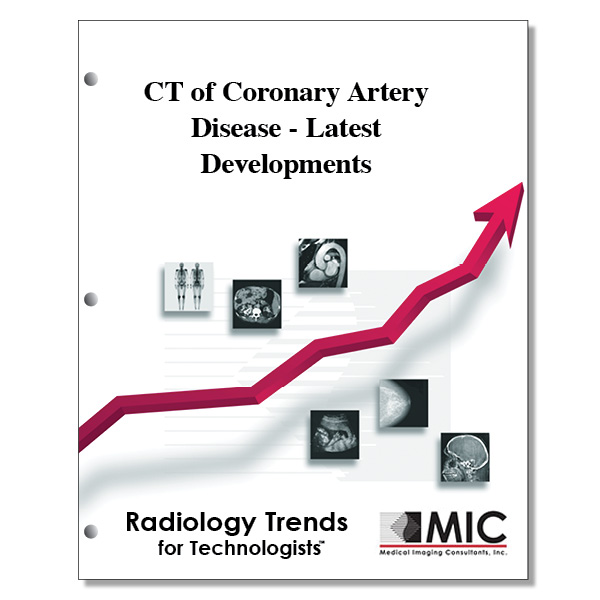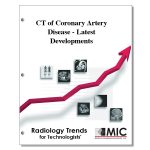

CT of Coronary Artery Disease – Latest Developments
A presentation of how rapidly evolving CT technology and a reduction in radiation dose have led to new applications, improved clinical cardiovascular disease management, and increased emphasis on cost-effectiveness.
Course ID: Q00290 Category: Radiology Trends for Technologists Modalities: Cardiac Interventional, CT, Nuclear Medicine3.25 |
Satisfaction Guarantee |
$34.00
- Targeted CE
- Outline
- Objectives
Targeted CE per ARRT’s Discipline, Category, and Subcategory classification for enrollments starting after February 8, 2023:
[Note: Discipline-specific Targeted CE credits may be less than the total Category A credits approved for this course.]
Cardiac-Interventional Radiography: 1.00
Procedures: 1.00
Diagnostic and Electrophysiology Procedures: 1.00
Computed Tomography: 3.25
Safety: 0.25
Radiation Safety and Dose: 0.25
Image Production: 0.50
Image Formation: 0.50
Procedures: 2.50
Neck and Chest: 2.50
Nuclear Medicine Technology: 1.00
Procedures: 1.00
Cardiac Procedures: 1.00
Registered Radiologist Assistant: 2.75
Safety: 0.25
Patient Safety, Radiation Protection, and Equipment Operation: 0.25
Procedures: 2.50
Thoracic Section: 2.50
Outline
- Introduction
- The Scope
- Technical Evolution
- Radiation Dose
- Framework for Appropriate Use and Indication
- Comparison with Conventional Coronary Angiography
- Beyond Feasibility Testing
- CT for Acute Chest Pain Assessment in the Emergency Department
- Left Ventricular Function
- Emerging Applications
- Coronary Atherosclerotic Plaque Imaging
- Myocardial Perfusion and Viability
- Coronary CT Angiography in a Changing Health Care Environment
- Emerging Data about Outcome and Prognosis
- Evolution of Cardiovascular Disease Management
- Cost-effectiveness
- Conclusion
Objectives
Upon completion of this course, students will:
- understand why coronary CTA is a widely accepted clinical application
- know reasons that there has been a decline in cardiovascular mortality
- be aware of what CT conditions cardiac scanning can evaluate
- realize the improvements in CT cardiac scanners
- be aware of the patient preparation for coronary CTA
- appreciate the advantages of the dual source scanners
- know what dual energy is
- realize that there are recommendations to reduce dose
- comprehend prospective ECG-triggering
- understand prospective ECG-triggering limitations
- know what recent advance allows for lower dose
- recognize potential patient candidates for coronary CTA
- be aware why coronary CTA is not recommended as a general screening test
- recognize what is the cornerstone for CT in management of symptomatic patients suspected of having CAD
- understand why dual source and multi detector scanners improve cardiac studies
- realize the potential for reducing blooming artifacts
- recognize what further tests are advised following an inconclusive coronary CTA
- be aware of the role of a triple rule out study
- appreciate that CTA scanning is as safe and accurate as another standard test
- appreciate how cardiac CT compares with other studies
- understand why cardiac CT will never be the primary test for cardiac function
- compare the function results of the early 4 row scanners to the 64 row scanners
- recognize what allows visual evaluation of wall motion
- appreciate how 256 and 320 detector row scanners will improve cardiac scanning
- be aware of what a rupture of plaques will be associated with
- comprehend why CT is the modality of choice for artery plaque analysis
- identify what will help to differentiate calcified vs non calcified plaque components
- compare information from exercise stress testing, rest stress US with CT
- understand the importance of multiple studies for cardiac evaluation
- realize the goals in attaining myocardial perfusion information
- comprehend the achievements made in attaing myocardial perfusion information
- recognize how principles from MR can be applied to CT for myocardial viability
- know what value of kV shows better iodine differentiation
- be aware of research study results about coronary CTA
- identify how management of CAD is changing
- know a prevention program for lowering CVD mortality
- appreciate cost-effectiveness for cardiac CTA
- recognize when conventional coronary catheterization is cost-effective
- realize for what group of patients having a CTA in the ER is the most cost-effective
- understand how the scope of coronary CTA is widening
